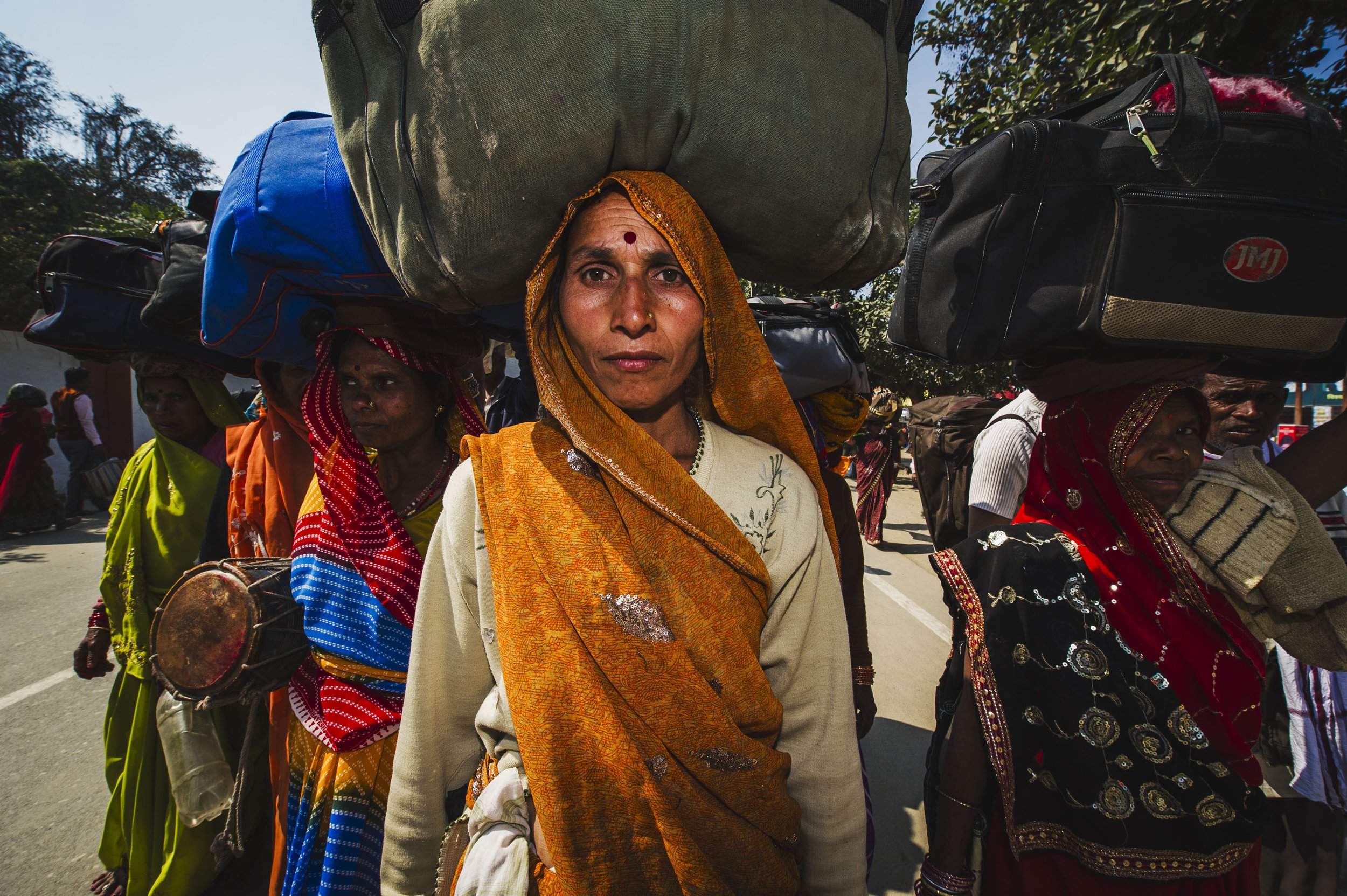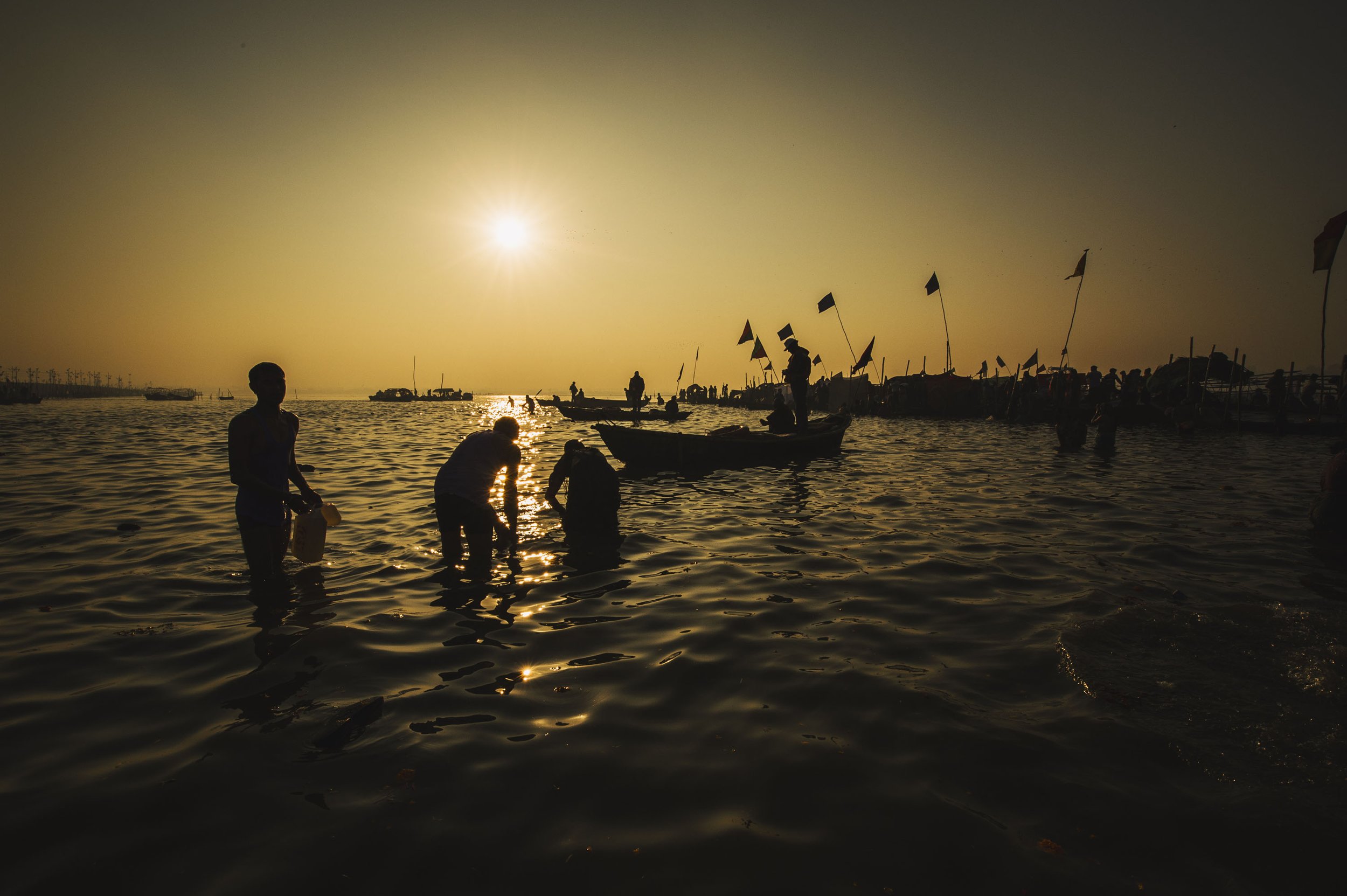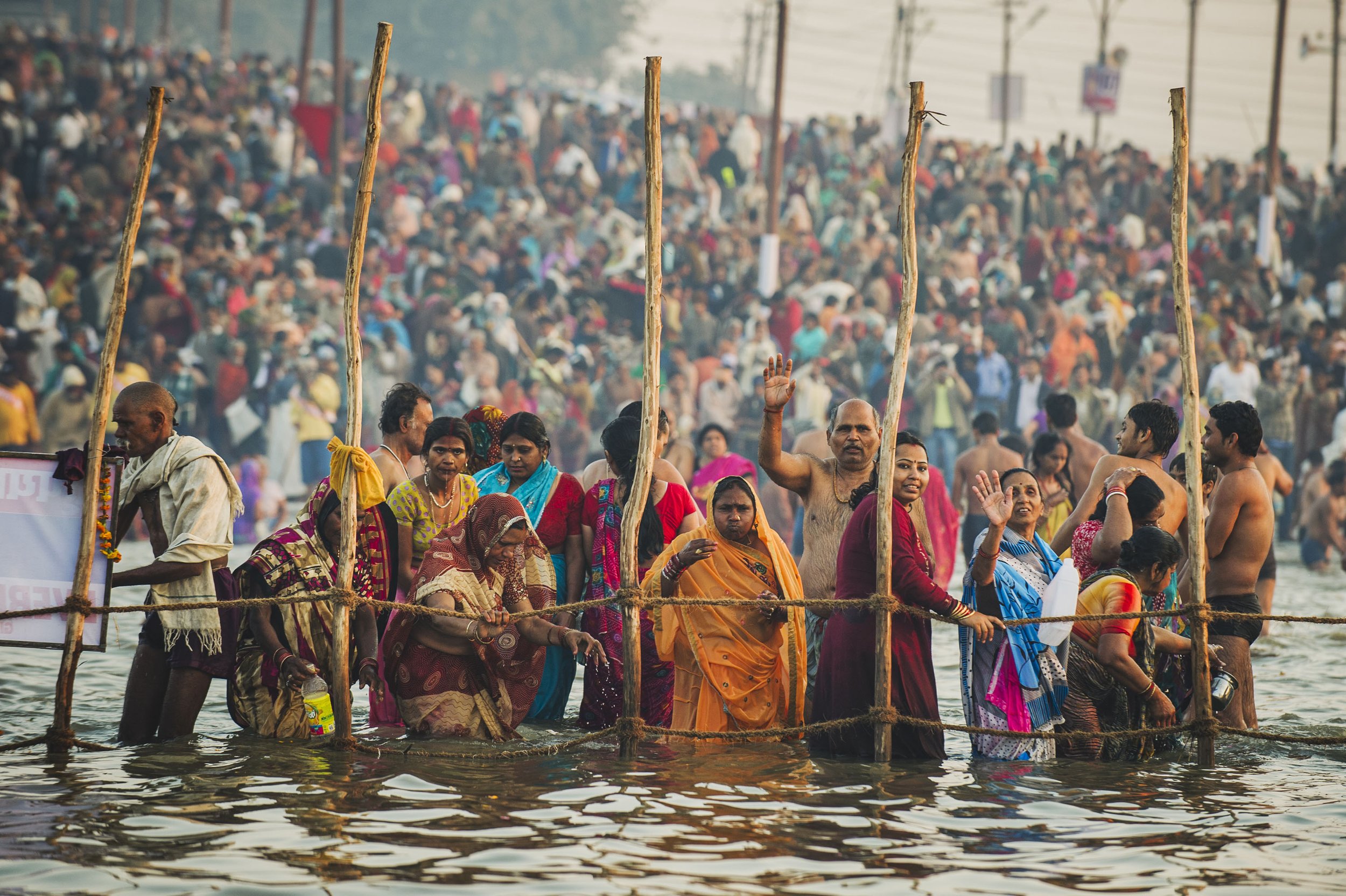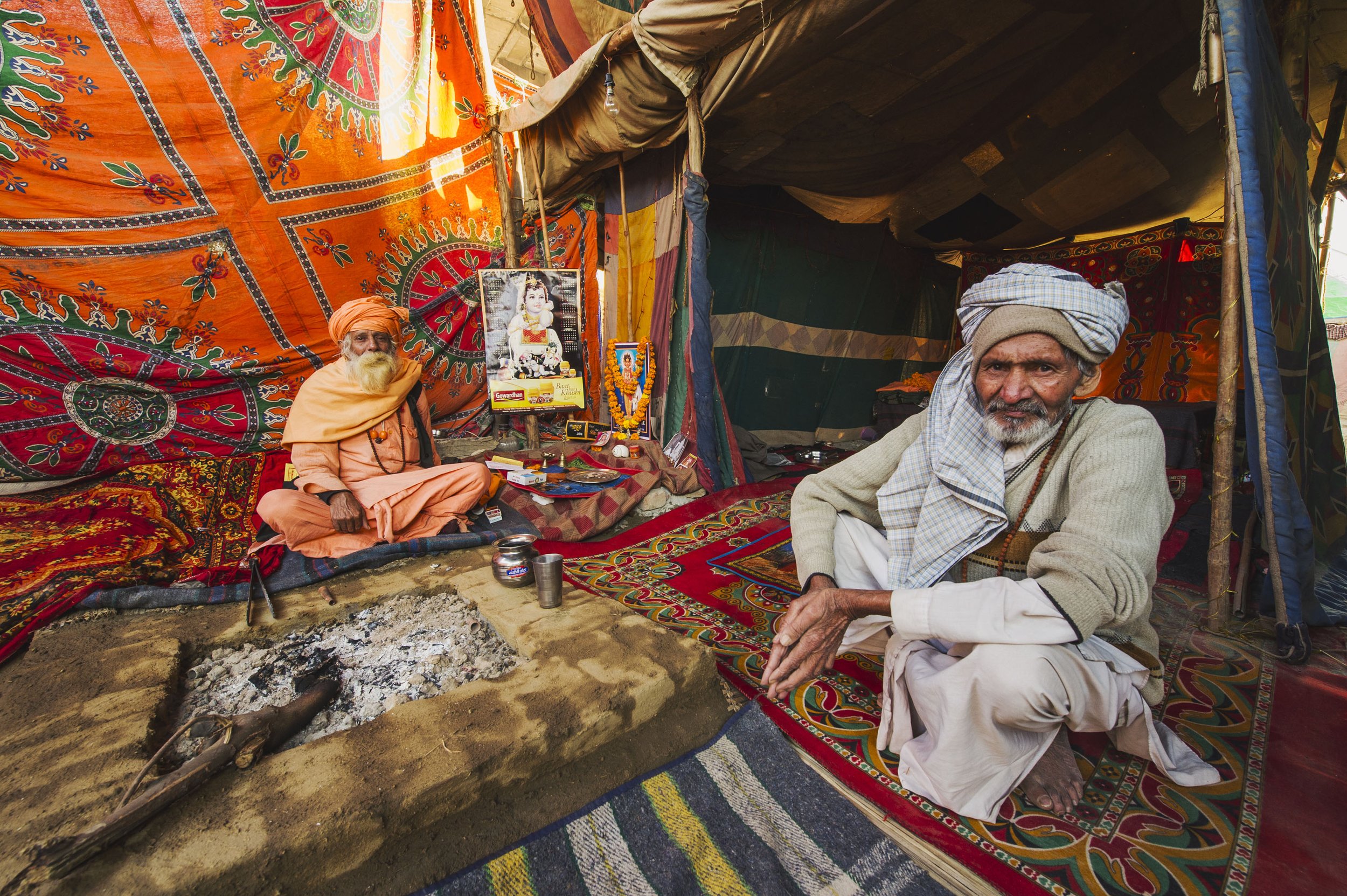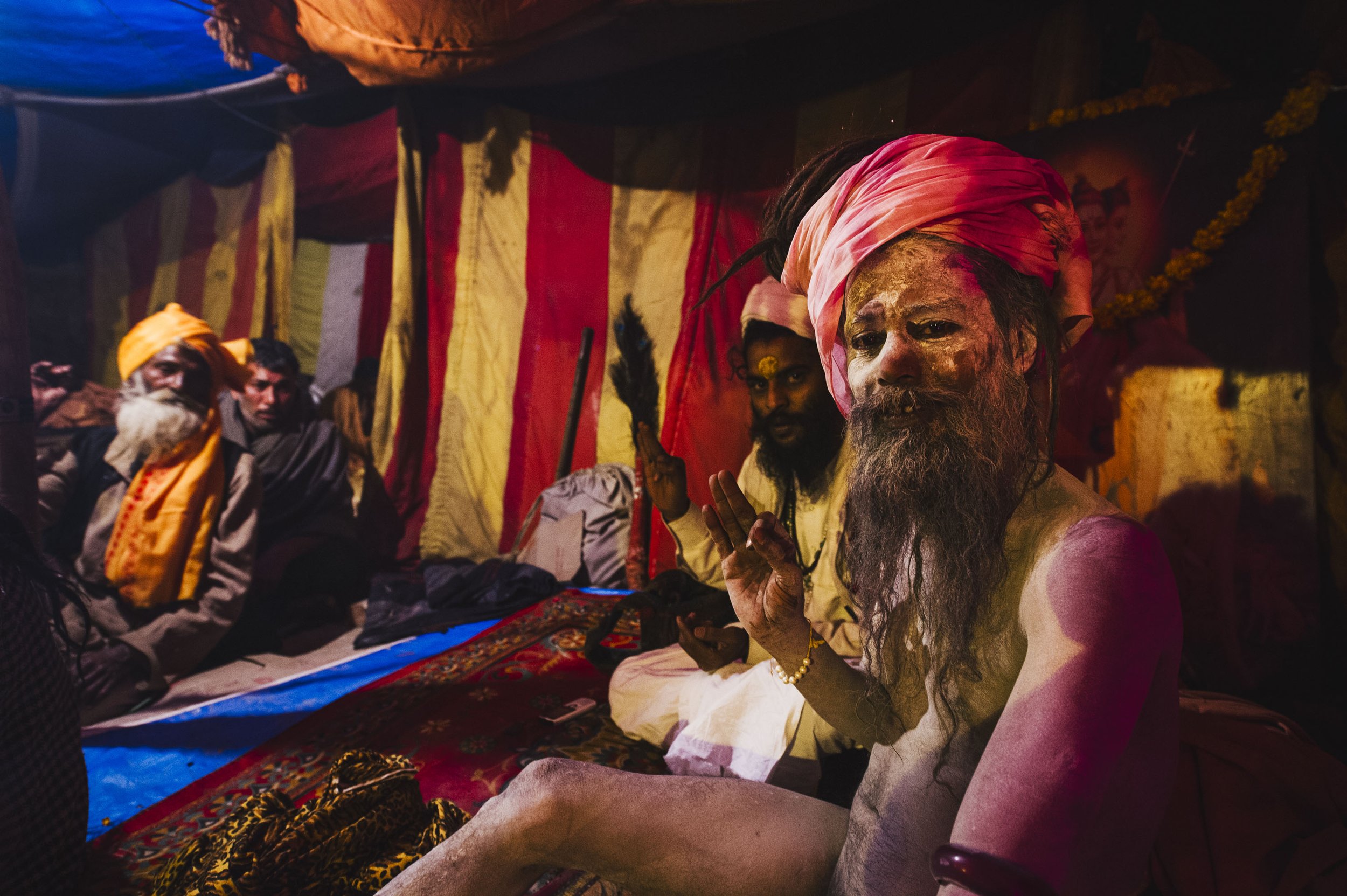India 2013
Kumbh Mela, Allahabad, Uttar Pradesh

One of the world’s most extraordinary and captivating spiritual events took place in the city of Allahabad, in the heart of India: The Kumbh Mela. The Ganges River's sacred banks are where this ancient Hindu ritual, dating back millennia, carries on a tradition of cyclical celebration that spans generations.
The Kumbh Mela is much more than a mere religious gathering; it is a transcendental experience that embraces the vastness of the human soul and the depth of faith. Millions of pilgrims from every corner of the globe flocked to the holy city of Allahabad to immerse themselves in the purifying waters of the
Ganges, believing that bathing during this auspicious period can wash away all sins and bring endless blessings.
The 2013 Kumbh Mela was a spectacle of colors, sounds, and scents, a mosaic of cultures, languages, and traditions that blended into a single spiritual ecstasy. Everyone found their own meaning in this vast human and divine spectacle, including wandering sadhus, common devotees, curious individuals, and truth-seekers.
Discover the magnificence of the 2013 Kumbh Mela in Allahabad by exploring stories, images, and testimonies that capture its essence. Through the pages of this virtual journey, we will travel together along sacred paths, meet those who lived and breathed the unique atmosphere of this spiritual gathering, and allow ourselves to be enveloped by the mystical aura that only the Kumbh Mela can offer.
The origins of the Kumbh Mela
As old and profound as the culture it emanates from, the story of the Kumbh Mela is also deeply rooted. Amrita, the elixir of immortality, is the focus of the story, which is inspired by Hindu mythology and revolves around the cosmic struggle between gods and demons. Samudra Manthan is the grand event that starts the story with the churning of the ocean of milk.
According to Hindu scriptures, the gods (Devas) and demons (Asuras) once decided to churn the ocean to obtain the nectar of immortality. They used Mount Mandara as the churning rod and the serpent Vasuki as the rope. As they churned, various divine and mystical objects emerged from the ocean. However, the most coveted prize was the Amrita, which appeared last.
The Devas, fearing that the Asuras would become invincible if they consumed the Amrita, sought the help of Lord Vishnu, who took the form of Mohini, a beautiful enchantress. With her divine charm and cunning, Mohini distracted the Asuras and distributed the Amrita only among the Devas.
However, during the commotion, drops of Amrita fell at four locations on Earth: Prayag (modern-day Allahabad), Haridwar, Nashik, and Ujjain. These places are now considered holy and are the sites where the Kumbh Mela is held in rotation.
The term "Kumbh" refers to the pitcher (Kumbha) that contained the Amrita. "Mela" means gathering or fair. Thus, the Kumbh Mela symbolizes the celestial event of the churning of the ocean and the quest for immortality.
The Kumbh Mela has developed into the largest religious gathering in the world over time, drawing millions of pilgrims from all over India and beyond. It is a time when sadhus, saints, and devotees come together to bathe in the sacred rivers, perform rituals, and seek spiritual enlightenment.
The significance of the Kumbh Mela is not limited to its religious impact but also extends to its cultural and social impact. It serves as a platform for spiritual discourse, cultural exchange, and social cohesion. Pilgrims from dierent backgrounds and beliefs come together, overcoming barriers of caste, creed, and nationality, to engage in the collective search for spiritual awakening.
The Kumbh Mela story is not only a mythological tale, but a living tradition that continues to inspire and unify millions on their spiritual journey. Faith, devotion, and the eternal quest for transcendence are all reflected in this testament.
Tens of Millions of People
Between February and March (the month of Magha), 80 million pilgrims bathed at the confluence of the Sangam, where the rivers Ganges, Yamuna, and the underground Saraswati meet.
According to Hindu belief, bathing at this juncture grants'moksha', liberation from the cycle of rebirths, and purification from sins. Prayag, also known as Allahabad to us Europeans, is where millions gather every twelve years for this reason.
The Shastri Bridge, which spans the Ganges, is where a sprawling expanse of tents unfolds on the three banks of the Sangam, a colossal tent city that was erected within months on the riverbed. Here, the 'ashrams' (meditation sites) of great gurus rise, their loudspeakers incessantly emitting mantras.
The Kumbh Mela can be likened to a veritable city, especially on February 10, 2013, during the Mauni Amavasya, the principal bathing day, when approximately 30 million pilgrims congregated. For this occasion, on the outskirts of Allahabad, 10 hospitals, 18 floating bridges, and 40 barracks housing 14,000 police officers, soldiers, and riot control forces were established, engaged day and night in overseeing the 11 massive encampments set up.
On the eve of the grand bath, pilgrims arrive incessantly, resembling a human "river": men, women carrying large bundles atop their heads, and children spend the night everywhere, along the streets, in temples, and in ashrams (meditation sites). Despite the darkness, pilgrims make their way to the river, which is illuminated by ochre-yellow lights, to take the sacred bath. The banks overflow with pilgrims who, seemingly in ecstasy, immerse themselves in the sacred waters, their eyes gleaming with enthusiasm, amid splashes, shouts, and hands raised towards the rising sun.
The streets of Kumbh Mela, Allahabad
The streets of Kumbh Mela, Allahabad
The streets of Kumbh Mela, Allahabad
View from the river at Kumbh Mela, Allahabad
Sadhu of Kumbh Mela, Allahabad
A Pilgrim of Kumbh Mela, Allahabad
A Pilgrim of Kumbh Mela, Allahabad
A Pilgrim of Kumbh Mela, Allahabad
Pilgrims of Kumbh Mela, Allahabad
A Pilgrim of Kumbh Mela, Allahabad
A Pilgrim of Kumbh Mela, Allahabad
Pilgrims of Kumbh Mela, Allahabad
Ashram of Kumbh Mela, Allahabad
Pontoon bridge of Kumbh Mela, Allahabad
Ashram of Kumbh Mela, Allahabad
Pontoon bridge of Kumbh Mela, Allahabad
A Pilgrim of Kumbh Mela, Allahabad
View of Kumbh Mela from Shastri bridge, Allahabad
View of Kumbh Mela from Shastri bridge, Allahabad
View of Kumbh Mela from Shastri bridge, Allahabad
The Holy Bath
The purifying bathing site is the Triveni Sangam, the confluence of India's three sacred rivers: Ganges, Yamuna, and Sarasvati (the latter being subterranean, due to a significant climatic upheaval that dried up its surface course approximately 3000 years ago).
These three sacred rivers originate from the lofty peaks of the Himalayas. The Ganges springs forth from a cave known as Gomukha, "cow's mouth"; its waters are rich in a natural clay possessing purification and healing properties (called tilaka), used by all religious practitioners to adorn their bodies with auspicious symbols, with designs varying according to their respective groups. The other two rivers, Yamuna and Sarasvati, originate from the same Himalayan region, but the latter becomes subterranean after about 100 kilometers of its course.
Mythologically, Mother Ganges originally flowed only on celestial planes (where it is called Mandakini), but King Bhagiratha implored her to descend to Earth to purify and liberate his sixty thousand ancestors. Pleased by the king's immense austerity, she consented to descend to Earth, where she was welcomed by the god Shiva himself. Yamuna is considered the daughter of the Sun and the twin sister of Yamaraja (the deity who judges departed souls and resides in Pitriloka, the "courtroom" planet of the universe). In Sanskrit, "yama" indeed means "twin." Its waters are as deep blue as the complexion of Krishna (an avatar, or a god descended or manifested on Earth, of the god Vishnu). The personification of the Sarasvati River is the goddess Sarasvati (also called Sarada, Vidyadevi, or Brahmani), revered by scholars, musicians, and artists, daughter of Lord Brahma, who bestows the blessings of wisdom and knowledge.
The Holy Bath at Kumbh Mela, Allahabad
The Holy Bath at Kumbh Mela, Allahabad
The Holy Bath at Kumbh Mela, Allahabad
The Holy Bath at Kumbh Mela, Allahabad
Litter left behind by pilgrims at Kumbh Mela, Allahabad
The Holy Bath at Kumbh Mela, Allahabad
The Holy Bath at Kumbh Mela, Allahabad
The Holy Bath at Kumbh Mela, Allahabad
The Holy Bath at Kumbh Mela, Allahabad
The Holy Bath at Kumbh Mela, Allahabad
The Holy Bath at Kumbh Mela, Allahabad
The Holy Bath at Kumbh Mela, Allahabad
The Holy Bath at Kumbh Mela, Allahabad
The Holy Bath at Kumbh Mela, Allahabad
The Holy Bath at Kumbh Mela, Allahabad
The Holy Bath at Kumbh Mela, Allahabad
Lifeguard at Kumbh Mela, Allahabad
The Holy Bath at Kumbh Mela, Allahabad
The Holy Bath at Kumbh Mela, Allahabad
The Holy Bath at Kumbh Mela, Allahabad
The Holy Bath at Kumbh Mela, Allahabad
The Holy Bath at Kumbh Mela, Allahabad
The Holy Bath at Kumbh Mela, Allahabad
The Holy Bath at Kumbh Mela, Allahabad
The Holy Bath at Kumbh Mela, Allahabad
The Holy Bath at Kumbh Mela, Allahabad
The Holy Bath at Kumbh Mela, Allahabad
The Holy Bath at Kumbh Mela, Allahabad
The Sadhus, True Charaters of the Kumbh Mela
Sadhus are ascetics, revered figures in the Hindu religion. Among them, the most renowned are the Naga Sadhus, militant ascetics devoted to Shiva (the god of creation and destruction), who walk naked with their bodies covered in ash, long beards, unkempt dreadlocks, and faces adorned with symbols of their respective deities.
On the other hand, the Parivajaka are ascetics who have taken a vow of silence and roam the streets ringing small bells to divert passersby from their path. The Shirshasin take their name from the Yoga position (asana) Shirshasana (headstand) and meditate for hours with their heads down. The Kalpvasi, on the other hand, reside on the riverbanks for the entire month of the Kumbha Mela, performing rituals and chanting mantras.
Walking through the tents of the Sadhus at the Kumbh Mela, one can witness some of them playing a large conch shell, evoking the sounds of creation. In other instances, groups of devotees can be found alongside Sadhus, smoking pipes called chillum filled with charas, a type of hashish common in northern India, derived from the extraction of resin from Cannabis Indica.
From a religious standpoint, the origin of this ritual stems from the mythological birth of the Cannabis plant, attributed to the god Shiva. Legend has it that upon reaching his sixteenth reincarnation, Shiva, distraught by the loss of his beloved Parvati, who renounced him, tore a seed from his thigh and cast it onto the surrounding mountains, giving rise to the spontaneous growth of the plants. To cope with the loss of his beloved, he dedicated himself until his death to consuming charas, which helped alleviate his sorrow. Presently, charas is still used by Sadhus to facilitate yoga meditation, and despite its official prohibition by the Indian state, its dissemination and usage, deeply rooted in local traditions, remain prevalent.
The Sadhu at Kumbh Mela, Allahabad
The Sadhu at Kumbh Mela, Allahabad
The Sadhu at Kumbh Mela, Allahabad
The Sadhu at Kumbh Mela, Allahabad
The Sadhu at Kumbh Mela, Allahabad
The Sadhu at Kumbh Mela, Allahabad
The Sadhu at Kumbh Mela, Allahabad
The Sadhu at Kumbh Mela, Allahabad
The Sadhu at Kumbh Mela, Allahabad
The Sadhu at Kumbh Mela, Allahabad
The Sadhu at Kumbh Mela, Allahabad
The Sadhu at Kumbh Mela, Allahabad
The Night of Pilgrims
Pilgrims, hailing from the sacred riverbanks, after their bath, set off by any means towards the long journey back home. The evening and nighttime spectacle is truly intense, with millions of people crowding the streets, floating bridges (pontoon bridges), tents, and near the pillars of the Shastri Bridge, cooking, praying, resting in preparation for the purifying dawn in the sacred river.
Walking on the floating bridges provides a spectacle of the flow of pilgrims traversing the Kumbh Mela, and pausing on the opposite bank of the Sangam reveals the sight of enormous encampments and ashrams.
From the Shastri Bridge, there is a picturesque view of the gathering of pilgrims; the ochre lights mixed with colorful attire create an almost surreal atmosphere. Descending into the heart of the Kumbh Mela, one can encounter Sadhus, pilgrims, and beggars spending the night and preparing for purification.
The dusty streets are dampened to reduce suspension and make the air more breathable; in every corner, one can find improvised fires that pilgrims use to warm themselves and dry their wet clothes. The entire night is an eternal procession of people arriving and departing, ceaselessly.
In some tents, Sadhus receive pilgrims who prostrate themselves at their feet to be blessed; sometimes, they even collect the soil that a saint has just trodden upon.
Devotion to the gods is not only perceptible in the tents of the Sadhus but also along the streets of the Kumbh Mela, where it is easy to encounter pilgrims silently praying hours before the purifying bath.
Many devotees gather in pandals - large tents - to listen to some of India's most famous gurus, attend lectures on spiritual and philosophical topics, or, in some cases, watch "theatrical reconstructions" of Indian dramas or classical dance groups.
For a photographer, the Kumbh Mela is a unique experience, regardless of their genre or preference. It is not just an experience to capture but a genuine material and spiritual adventure.
During the days spent in Allahabad with some Indian journalists and photographers, I tried to better understand their culture, gaining a worldview vastly different from the European one. I wanted to include as the final testament to this wonderful experience some portraits, snapshots, and memories of special encounters.
The night of pilgrims at Kumbh Mela, Allahabad
The night of pilgrims at Kumbh Mela, Allahabad
The night of pilgrims at Kumbh Mela, Allahabad
The night of pilgrims at Kumbh Mela, Allahabad
The night of pilgrims at Kumbh Mela, Allahabad
The night of pilgrims at Kumbh Mela, Allahabad
The night of pilgrims at Kumbh Mela, Allahabad
The night of pilgrims at Kumbh Mela, Allahabad
The night of pilgrims at Kumbh Mela, Allahabad
The night of pilgrims at Kumbh Mela, Allahabad
The night of pilgrims at Kumbh Mela, Allahabad
The night of pilgrims at Kumbh Mela, Allahabad
The night of pilgrims at Kumbh Mela, Allahabad
The night of pilgrims at Kumbh Mela, Allahabad
The night of pilgrims at Kumbh Mela, Allahabad
The night of pilgrims at Kumbh Mela, Allahabad
The night of pilgrims at Kumbh Mela, Allahabad
The night of pilgrims at Kumbh Mela, Allahabad
The night of pilgrims at Kumbh Mela, Allahabad
The night of pilgrims at Kumbh Mela, Allahabad
The night of pilgrims at Kumbh Mela, Allahabad
The night of pilgrims at Kumbh Mela, Allahabad
The night of pilgrims at Kumbh Mela, Allahabad
The night of pilgrims at Kumbh Mela, Allahabad
Kumbh Portraits
The people I portrayed during the Kumbh Mela were a diverse tapestry of humanity, each bearing a unique story and journey. Through the lens of my camera, I sought to capture not just their physical features but also the depth of their experiences, emotions, and spiritual fervor.
Among the pilgrims, there were faces weathered by years of devotion, etched with lines of wisdom and faith. Their eyes, gleaming with determination and reverence, reflected the sacred journey they embarked upon. From the humble devotee to the revered Sadhu, each individual I encountered carried within them a profound sense of purpose and devotion.
In each portrait, I endeavored to capture the essence of their soul, the raw emotion etched upon their faces, and the timeless wisdom that emanated from their gaze. Whether they were lost in silent prayer, immersed in the rituals of purification, or simply basking in the divine aura of the Kumbh Mela, every person I portrayed was a testament to the power of faith and devotion.
Beyond the surface, each encounter was a precious meeting of hearts and minds, a fleeting connection forged amidst the bustling crowds and sacred rituals. In the exchange of smiles, nods, and gestures, there existed a silent understanding, a recognition of our shared humanity and spiritual journey.
Through these encounters, I gained insights into the rich tapestry of Indian culture and spirituality, as well as a deeper appreciation for the universal quest for meaning and transcendence. Each portrait became a window into the soul of the Kumbh Mela, a reflection of the countless stories, hopes, and dreams that converged upon the sacred confluence of the Ganges, Yamuna, and Saraswati.
As I reflect upon the people I portrayed during the Kumbh Mela, I am reminded of the profound beauty and diversity of the human experience, and the enduring power of faith to unite and uplift us all.
Pilgrims at Kumbh Mela, Allahabad
Pilgrims at Kumbh Mela, Allahabad
Pilgrims at Kumbh Mela, Allahabad
Pilgrims at Kumbh Mela, Allahabad
Pilgrims at Kumbh Mela, Allahabad
Pilgrims at Kumbh Mela, Allahabad
Pilgrims at Kumbh Mela, Allahabad
Pilgrims at Kumbh Mela, Allahabad
Pilgrims at Kumbh Mela, Allahabad
Pilgrims at Kumbh Mela, Allahabad
Pilgrims at Kumbh Mela, Allahabad
Pilgrims at Kumbh Mela, Allahabad
Pilgrims at Kumbh Mela, Allahabad
Pilgrims at Kumbh Mela, Allahabad
Pilgrims at Kumbh Mela, Allahabad
Pilgrims at Kumbh Mela, Allahabad
Pilgrims at Kumbh Mela, Allahabad
Pilgrims at Kumbh Mela, Allahabad
Pilgrims at Kumbh Mela, Allahabad
Pilgrims at Kumbh Mela, Allahabad
Pilgrims at Kumbh Mela, Allahabad







